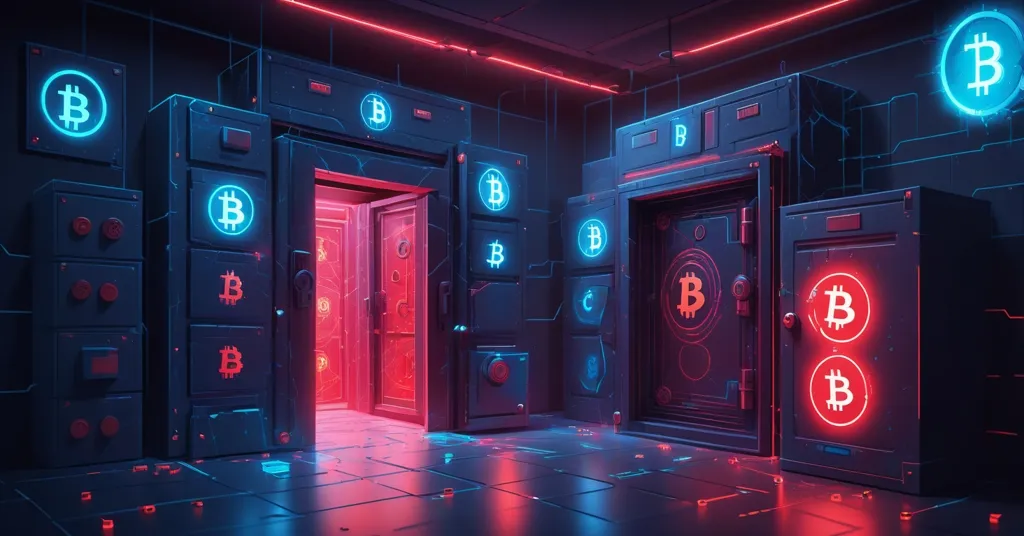OKX Review 2025: Safe and Legit for Bitcoin & Crypto Trading?

OKX Review 2025: Is It Safe and Legit for Bitcoin & Crypto Trading?
OKX has positioned itself as a heavyweight in the cryptocurrency exchange arena since its inception in 2017, promising a secure and versatile platform for trading Bitcoin and beyond. With a global footprint and a suite of innovative tools, it’s a name that often pops up for traders eyeing 2025’s market moves—but does it truly hold up under scrutiny, or are there hidden pitfalls in this shiny facade?
- Platform Powerhouse: OKX offers trading for over 350 cryptocurrencies with low fees and advanced tools like bots and copy trading.
- Security Stance: Robust safeguards with 95% cold storage and a $700M risk fund, yet compliance hiccups frustrate users.
- Global Gaps: Accessible in 100+ countries but barred from key markets like the US for full trading services.
OKX at a Glance: What You’re Getting
Founded in 2017 by Star Xu, OKX—once known as OKEx—has built a reputation as a go-to exchange for crypto enthusiasts. Headquartered in Seychelles, with offices stretching from Hong Kong to Silicon Valley, it’s a global operation that supports over 350 cryptocurrencies and 500+ trading pairs. Whether you’re buying Bitcoin as a first-timer or diving into obscure altcoins as a seasoned trader, OKX delivers a toolkit that spans spot trading (buying and selling at current prices), margin trading (borrowing to amplify gains or losses), futures, perpetual swaps, and options. Their mobile app for iOS and Android keeps you plugged in anywhere, while features like 11 types of trading bots—think automated assistants executing trades based on your rules—and copy trading, where novices mimic expert moves, aim to cater to all skill levels. For a deeper dive into the platform’s offerings, check out this comprehensive OKX review for 2025.
Beyond trading, OKX is dipping its toes into the decentralized future with the OKX Wallet, a gateway to Web3 applications like decentralized finance (DeFi) and NFT marketplaces. For those unfamiliar, Web3 is the blockchain-based evolution of the internet, prioritizing user control over data and transactions—think of it as the anti-Google. This blend of centralized exchange muscle and decentralized ambition makes OKX intriguing, but let’s dig deeper into whether it’s all substance or just slick marketing.
Fees: Cheap Thrills or Hidden Bites?
Ever felt your crypto profits evaporate under a barrage of sneaky fees? OKX aims to dodge that burn with some of the lowest rates in the game. Spot trading starts at 0.08% for makers (those adding liquidity by placing orders) and 0.10% for takers (those taking existing orders), while futures trading fees are even tighter at 0.02% maker and 0.05% taker for non-VIP users. High rollers or holders of OKX’s native token, OKB, can unlock steeper discounts through their VIP tiers. Speaking of OKB, it’s more than a shiny bauble—you can use it to pay fees, vote on platform governance, and earn rewards via OKX Earn programs. Handy if you’re all-in on their ecosystem, but let’s not pretend it’s a game-changer unless you’re married to OKX.
Compared to competitors, these fees are competitive, often undercutting Binance on certain pairs. But beware: low fees don’t mean free lunch. Hidden costs can creep in with withdrawals or exotic trading pairs, so always double-check the fine print before you dive in. For Bitcoin purists looking to stack sats without bleeding cash, OKX’s fee structure is a green light—just don’t expect miracles if you’re dabbling in low-liquidity altcoins. For a detailed breakdown of how OKX stacks up, see this OKX vs Binance comparison.
Security: Fortress or Facade?
In a post-FTX world where trust is scarcer than a Bitcoin bull run, OKX flexes hard on security—and they’ve got the specs to back it up. A whopping 95% of user assets sit in cold storage, offline vaults untouchable by hackers unless someone’s got a digital blowtorch. They cap each wallet at 1,000 BTC to spread risk, and layer on multi-factor authentication, anti-phishing codes, and withdrawal address whitelisting to keep your funds locked down. Their risk shield fund, valued at over $700 million, acts as a safety net akin to Binance’s Secure Asset Fund for Users (SAFU), ready to cover losses if disaster strikes. Curious how their fund measures up? Explore this comparison of OKX’s risk shield and Binance’s SAFU fund.
Transparency gets a nod too. As of December 2024, OKX’s proof of reserves—basically a public peek into their vault—shows over $30.8 billion in assets, with Bitcoin backed at 105%, Ethereum at 102%, and Tether USDT at 106%. They use cryptographic tricks like zero-knowledge proofs, letting users independently verify these numbers. For the uninitiated, proof of reserves is like a bank proving it’s got your cash on hand, except it’s math on a blockchain. This isn’t the shady “trust me, bro” accounting that tanked other exchanges, and it’s a big reason OKX scores trust points. For the latest on their reserves, take a look at OKX’s December 2024 verification reports.
But here’s the devil’s advocate bit: no fortress is impregnable. A massive black swan event—think a billion-dollar hack or systemic collapse—could test that $700 million fund faster than you can say “Mt. Gox.” History shows no safety net is foolproof; just ask Terra victims. While OKX hasn’t faced a major breach recently, their 2020 withdrawal suspension tied to Star Xu’s legal troubles in China is a reminder that even big players stumble. Have they truly turned a new leaf, or is this security swagger just good PR until the next storm hits?
Compliance Chaos: When Systems Betray Users
Here’s where OKX’s polished armor shows some rust. Despite the security bravado, their compliance systems have turned into a Kafkaesque nightmare for some users. In July 2025, CEO Star Xu publicly apologized for account lockouts caused by “false positives” in their risk detection algorithms, where everyday traders get flagged as suspicious for no apparent reason. Some have been stuck since June 2025, facing absurd verification demands—like providing a decade of work history or proving familial ties. Xu himself called out the insanity, noting:
One of the biggest challenges in global compliance is ‘false positives’ — where the system mistakenly flags normal users as risky.
He added that regulators often push exchanges to “err on the side of caution,” turning compliant users into collateral damage. Imagine you’re a small-time Bitcoin holder, and suddenly OKX freezes your account, demanding to know where your grandpa worked in 1995. That’s not just a glitch; it’s a betrayal of trust. Sure, overzealous gatekeeping might be necessary in a world rife with crypto scams, but screwing over legit users isn’t the answer. This isn’t unique to OKX—every major exchange grapples with this—but when your funds are locked, that’s cold comfort. For more on these issues, read about OKX’s compliance challenges in 2025.
How long do these freezes last? Reports suggest weeks to months, with little compensation offered. Compared to competitors, OKX isn’t alone in this mess, but their handling of user frustration—often slow responses and rejected proof-of-funds docs—leaves a sour taste. For a platform pushing mass adoption, this kind of bureaucratic BS is a glaring misstep. Background on their founder and related regulatory hurdles can be found in this piece on Star Xu and OKX’s challenges.
Global Game: Where OKX Plays and Where It’s Benched
OKX’s reach spans over 100 countries, making it a global titan, but regulatory red tape benches it in key markets. If you’re in the US, Belgium, France, Iran, or North Korea, full trading services are off the table. In Canada, Japan, and the UK, derivatives like futures face partial restrictions. For US users, there’s a sliver of access via Web3 tools through the OKX Wallet, but don’t expect to trade Bitcoin or altcoins directly. This patchwork availability highlights the ongoing clash between crypto innovation and government oversight, a tension set to intensify in 2025 as frameworks like the EU’s MiCA (Markets in Crypto-Assets) regulation roll out stricter AML and KYC rules. For a broader overview of the exchange, refer to the OKX Wikipedia page.
Being based in Seychelles—a haven for crypto firms due to lax oversight—gives OKX some wiggle room compared to exchanges tied to heavier jurisdictions. But as regulators worldwide tighten the noose, will this offshore edge save them, or will users bear the brunt of compliance crackdowns? It’s a gamble, especially if you’re in a gray-area market where access could vanish overnight.
OKX vs. Binance: Who Wins Your Wallet?
These regional roadblocks aren’t unique to OKX, so how does it stack up against a juggernaut like Binance? On liquidity—the lifeblood of trading—Binance often takes the crown with deeper order books and a broader coin selection. Their reputation and educational resources also draw a mainstream crowd. OKX counters with lower fees on select pairs and a sharper focus on niche traders obsessed with altcoins or futures. Community buzz on platforms like Quora and X paints OKX as a darling for DeFi enthusiasts thanks to its wallet integrations, while Binance wins for raw trading volume. Wondering about user trust and safety? Check out community feedback on OKX’s legitimacy for Bitcoin trading.
Then there’s innovation. OKX’s copy trading lets rookies shadow pros, and their trading bots offer automation that Binance doesn’t match as seamlessly. But liquidity matters—if you’re moving big Bitcoin stacks, Binance’s deeper pools might save you from slippage headaches. Your pick depends on style: OKX for versatility and DeFi flair, Binance for stability and scale. Neither’s perfect, but both reflect crypto’s messy growing pains.
Web3 and DeFi: Decentralized Dreams or Marketing Hype?
OKX isn’t just playing the centralized exchange game; it’s flirting with the decentralized frontier through the OKX Wallet. This non-custodial tool supports multiple blockchains, letting you interact with DeFi protocols (think lending or yield farming without middlemen) and NFT platforms directly. It’s a bridge between OKX’s walled garden and the wild west of Web3, where users—not tech giants—own their data and assets. For Bitcoin maximalists, this might seem like a distraction from the pure vision of peer-to-peer money, but it aligns with broader blockchain disruption, a key pillar of the financial revolution we champion.
Yet, let’s play skeptic: is OKX genuinely pushing user sovereignty, or just riding the DeFi hype to lure folks who’ll stick to centralized trading anyway? A centralized exchange dabbling in decentralization feels like a wolf in sheep’s clothing—still holding the reins over your account if compliance flags pop up. Their wallet supports major chains like Ethereum and Polygon, but how deep is the integration? Can it rival pure DeFi wallets like MetaMask, or is it a shiny add-on to keep you in OKX’s orbit? For real user experiences, browse through discussions on OKX’s security and user feedback. For now, it’s a step toward decentralization, but don’t mistake it for the full ethos of crypto freedom.
Bitcoin Focus: Maximalist Haven or Altcoin Circus?
Given our lean toward Bitcoin maximalism, let’s zero in on OKX’s role for BTC diehards. Their low fees and over 100% reserve backing for Bitcoin are a solid on-ramp for stacking sats without getting gouged. Security measures cater to the “not your keys, not your crypto” crowd wary of exchange collapses. But supporting 350+ altcoins and a sprawling DeFi playground raises eyebrows—does this dilute focus on the king of crypto, or does it pragmatically fill niches Bitcoin doesn’t touch? We’d argue the latter; altcoins and Ethereum-based innovations drive experimentation that indirectly strengthens the ecosystem, even if BTC remains the ultimate store of value. OKX balances both worlds, but if you’re a purist, their altcoin bazaar might feel like unnecessary noise.
Looking to 2025: Can OKX Keep Pace?
As we peer into 2025, OKX’s trajectory hinges on navigating a tightening regulatory maze. Stricter AML and KYC rules, especially in Europe, could amplify compliance headaches—more false positives, more frozen accounts. Their Seychelles base offers a buffer, but if global frameworks sync up, even offshore havens won’t escape the heat. On the flip side, OKX’s tools like bots and Web3 integrations position it to accelerate crypto’s disruption of traditional finance, embodying the effective accelerationism (e/acc) ethos we back. Trading automation and DeFi access could speed up adoption, assuming they don’t trip over centralized control issues.
The $700 million risk fund is a cushion, but its real-world deployment in a crisis remains untested compared to Binance’s SAFU track record. And while user gripes on X and Reddit highlight spotty customer support, every exchange has detractors—does OKX’s innovation outweigh the noise? Only time will tell if they can iron out operational kinks while pushing the boundaries of what a crypto platform can be.
Practical Tips for OKX Users
For those considering OKX, here’s a quick breakdown by experience level. New to crypto? Stick to spot trading for simplicity and use copy trading to learn from pros without risking big losses. Mid-tier trader? Explore margin and futures, but tread lightly—these are high-stakes bets on price moves, not buy-and-hold plays. Seasoned whale? Leverage their bots for automation, but keep an eye on compliance traps; have backup exchanges ready if a freeze hits. No matter your level, always enable every security feature—multi-factor authentication isn’t optional in this Wild West.
Final Verdict: Should You Trust OKX in 2025?
OKX makes a compelling case as a legit platform for Bitcoin and crypto trading in 2025, with dirt-cheap fees, a security setup that’s tough to crack, and a forward-thinking nod to Web3. But compliance chaos and geographic barriers are a reality check—no exchange escapes the growing pains of a maturing, overregulated industry. For those willing to stomach occasional bureaucratic nonsense, OKX offers a killer toolkit for both Bitcoin maximalists and altcoin explorers. If user friction or regulatory red tape is a dealbreaker, though, you might shop around. Crypto’s never been plug-and-play, and OKX, for all its strengths, embodies that chaotic charm. So, is it your trading home for 2025, or just another exchange with shiny promises and hidden traps? That’s your call.
Key Questions and Takeaways
- Is OKX safe for Bitcoin and crypto trading in 2025?
Largely, yes—95% cold storage, a $700M risk fund, and $30.8B in transparent reserves scream security. But compliance-driven account freezes expose operational flaws that can erode trust fast. - Why are US users blocked from trading on OKX, and does it matter?
Strict regulatory hurdles bar full trading in the US, though Web3 tools are accessible. It’s a big deal if you’re stateside and want core exchange features, pushing you to rivals like Binance. - How does OKX serve beginners and advanced traders alike?
Newbies get a simple interface and copy trading to follow experts, while pros access bots and derivatives. Versatility shines, though advanced tools have a learning curve. - What’s the value of the OKB token for users?
OKB slashes fees, grants governance votes, and offers rewards if you’re tied to OKX’s ecosystem. It’s nice but not essential unless you’re a platform loyalist. - Are compliance issues a dealbreaker for OKX?
Not always—they’re an industry-wide pain. But if endless verification demands or frozen funds frustrate you, these real user headaches could sour the whole experience. - Can OKX balance centralized power with DeFi ambitions?
Their Web3 wallet is a promising start, linking to DeFi and NFTs, but centralized control over accounts clashes with true decentralization. It’s a half-step, not a leap, toward crypto freedom.


